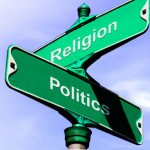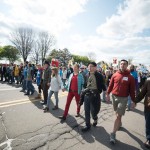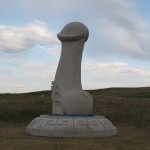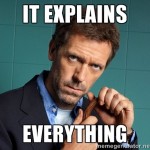Over at Bishop in the Grove, Teo Bishop took issue with the singing of Paganized Christian hymns in his group’s Yule ritual. The complaint was that it was disingenuous, and that Pagans need to develop our own music. I want to respond to this on a few levels: first on the question of Pagan music, second the question of re-appropriation, and finally on the question of the relationship of Neo paganismwith Christianity.
1. Pagan Music
There is no dearth of Pagan music. It is there to be found. Of course, it takes more work than finding a Christian hymn, but what would you expect?
Who do I like? Well, Gwydion Pendderwen is a classic. My favorite is probably “Lord of the Dance”. I have heard that this was a traditional Pagan song that was subsequently Christianized, but I don’t think that is the case. In any case, Aidan Kelly and Gwydion Pendderwen (and possibly others) (re-)Paganized it. The Christian original, I believe, was written by Sydney Carter (who also wrote “Julian of Norwich” — also worth checking out). I played both the Christian and the Pagan versions at one of our family rituals: Todd Alan’s Pagan version from The Best of Pagan Song is great. (I love the lyrics. Check them out here and here.) The Christian acappella version recorded by Lordsong is amazing though! But it can also be sung like an Irish drinking song, like it is by the Dubliners
I’ve gotten a lot of use out of Damh the Bard in my family rituals. The lyrics are great. My favorite I think is “Noon of the Solstice”. But I probably use Thorn Coyle and Sharron Knight’s seasonal chants in Songs for the Strengthening Sun and Songs for the Waning Year most. We used their “Solstice Prayer” as a prelude in our last ritual. We also used other of their chants as a ritual colloquy between the Sun Child and Mother Night. (You can find the lyrics in the last post.)
I also have used several songs from the Unitarian Universalist Hymnals (there’s two of them). We sang “Rising Green” by Carol McDade (hymn #1068) at our Spring Equinox celebration:
My blood doth rise in the roots of yon oak.
Her sap doth run in my veins.
Boundless my soul like the open sky where the stars forever have lain
Where the stars, Where the stars, where the stars forever have lain
My hands hold the weavings of time without end
My sight as deep as the sea.
Beating my heart sounds the measures of old, that of love’s eternity
That of love, that of love, that of love’s eternity
I feel the tides as they answer the moon rushing on a far distant sand
Winging my song is the wind of my breast and my love blows over the land
And my love, and my love, and my love blows over the land.
My foot carries days of old into new, our dreaming shows us the way.
Wondrous our faith settles deep in the earth, rising green to bring a new day.
Rising green, rising green, rising green to bring a new day.
More recently, we sang “Winter Solstice Chant” by Phillip Palmer (#1063). (You can find the lyrics in my last post too.)
I would love to hear Kenny Klein, one of the founders of the Blue Star Wicca tradition, but I can’t track his work down. Enya is an obvious choice for ambient music, as is Celtic Woman. Loreena McKennit is great, as is Gaia Consort.
But my personal favorite is Daemonia Nymphe, which plays ancient Greek music with authentic instruments. The lyrics are ancient Greek and many follow the Orphic hymns. I discovered them through the Darker Shade of Pagan Pagan music blog. If you don’t want to work your way through all that alternative music, just check out Jason’s annual Top-10 lists on his other blog, The Wild Hunt.
Last, but far from least, if you are a little more eclectic, you have got to consider Star Foster’s music lists which offer 13 songs for each Sabbat. She has at least one for each Sabbat and it includes Pagan and non-Pagan music alike. I have links to her lists on my page here. One of the most moving songs we sang as a family was Hall and Oates “Ooh Child” at our Spring Equinox ritual. We also sang “Here Comes the Sun” by the Beatles.
2. Borrowing
This brings me to the question of borrowing. Someone asked of Teo where the Pagan Bach and Pagan Mozart are. Well, how about the Back and Mozart? Why not use them? Hell, we Pagans have a long history of “borrowing”. We borrow myths from ancient cultures (usually ripping them right out of their culture context). Almost the entire Wiccan Book of Shadows was borrowed by Gardner from some other source. I don’t see anything wrong with borrowing, as long as you acknowledge your sources.
As several people pointed out in response to Teo’s blog, the tunes of many of the Christian hymns and carols were originally secular. Some of them were even drinking songs. Putting new lyrics to old tunes has a long and respectable history. In a way, we may just be closing the circle on that tradition when we (re-)Paganize Christmas carols. How many times have we heard Pagans proclaiming loudly that Christmas is a bastardized Yule? If that’s the case, why not re-appropriate it? In addition to the songs mentioned above, my family also sang Paganized carols this year again: “Silent Night” and “Joy to the World”. (Again, you can find the Paganized lyrics in the last post.) If you prefer to not alter traditional songs, there are Christian songs and carols that have pagan themes. Consider “The Holly and the Ivy”:
The holly and the ivy, now both are full well grown,
Of all the trees that are in the wood, the holly bears the crown.
Refrain:
Oh, the rising of the sun and the running of the deer,
The playing of the merry organ, sweet singing in the choir.
The holly bears a blossom as white as lily flower,
And Mary bore sweet Jesus Christ to be our sweet saviour
The holly bears a berry as red as any blood,
And Mary bore sweet Jesus Christ to do poor sinners good.
The holly bears a prickle as sharp as any thorn,
And Mary bore sweet Jesus Christ on Christmas Day in the morn.
The holly bears a bark as bitter as any gall,
And Mary bore sweet Jesus Christ for to redeem us all.
But I suspect that the real concern about Paganized Christmas carols is not the borrowing, but the Christian association. The problem is not so much finding Pagan songs for rituals, but finding Pagan songs for winter solstice rituals. Why is this the case?
Part of the reason may be that the winter solstice has been considered a “minor Sabbat” for years and Samhain is considered the Pagan New Year. I have complained elsewhere that it makes no sense. The fact that Samhain is listed first in the Tochmarc Emire (“The Wooing of Emer”) has led to the modern Neopagan belief that Samhain was the Celtic New Year. According to Ronald Hutton, it is true that Samhain was the most important of the four festivals, but this does not necessarily mean it was considered the New Year Day. The Ulster tale of Echtra Nerai or Tain Bo Aingen, the “Adventures of Nera or the Cattle Raid of Angen”, refers to Samhain as “the end of the year”, but it is possible that Samhain represented the “[beginning of the] end of the year”, i.e., winter, without also representing the beginning of the new year, i.e., spring. The medieval Irish and English observed the New Year on either January 1 or March 25 (spring equinox) and this makes sense mythologically speaking.
But I am off topic. In any case, saying that there are few Pagan solstice songs because the solstice is a minor holiday may beg the question. Why is the winter solstice treated as a minor holiday by Pagans? I suspect it is for the same reason there are few Pagan solstice songs: Neopagans have an aversion to all things Christian. And this will be the topic of my next post.















